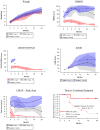Natural history of infantile-onset spinal muscular atrophy
- PMID: 29149772
- PMCID: PMC5776712
- DOI: 10.1002/ana.25101
Natural history of infantile-onset spinal muscular atrophy
Abstract
Objective: Infantile-onset spinal muscular atrophy (SMA) is the most common genetic cause of infant mortality, typically resulting in death preceding age 2. Clinical trials in this population require an understanding of disease progression and identification of meaningful biomarkers to hasten therapeutic development and predict outcomes.
Methods: A longitudinal, multicenter, prospective natural history study enrolled 26 SMA infants and 27 control infants aged <6 months. Recruitment occurred at 14 centers over 21 months within the NINDS-sponsored NeuroNEXT (National Network for Excellence in Neuroscience Clinical Trials) Network. Infant motor function scales (Test of Infant Motor Performance Screening Items [TIMPSI], The Children's Hospital of Philadelphia Infant Test for Neuromuscular Disorders, and Alberta Infant Motor Score) and putative physiological and molecular biomarkers were assessed preceding age 6 months and at 6, 9, 12, 18, and 24 months with progression, correlations between motor function and biomarkers, and hazard ratios analyzed.
Results: Motor function scores (MFS) and compound muscle action potential (CMAP) decreased rapidly in SMA infants, whereas MFS in all healthy infants rapidly increased. Correlations were identified between TIMPSI and CMAP in SMA infants. TIMPSI at first study visit was associated with risk of combined endpoint of death or permanent invasive ventilation in SMA infants. Post-hoc analysis of survival to combined endpoint in SMA infants with 2 copies of SMN2 indicated a median age of 8 months at death (95% confidence interval, 6, 17).
Interpretation: These data of SMA and control outcome measures delineates meaningful change in clinical trials in infantile-onset SMA. The power and utility of NeuroNEXT to provide "real-world," prospective natural history data sets to accelerate public and private drug development programs for rare disease is demonstrated. Ann Neurol 2017;82:883-891.
© 2017 American Neurological Association.
Conflict of interest statement
The authors have nothing to report.
Figures



Comment in
-
NeuroNEXT is at your service.Ann Neurol. 2017 Dec;82(6):857-858. doi: 10.1002/ana.25100. Epub 2017 Dec 4. Ann Neurol. 2017. PMID: 29149769 No abstract available.
-
Building on NeuroNEXT: Next generation clinics to cure chronic neurological disability.Ann Neurol. 2017 Dec;82(6):859-862. doi: 10.1002/ana.25108. Epub 2017 Dec 8. Ann Neurol. 2017. PMID: 29171907 Free PMC article. No abstract available.
References
-
- Zerres K, Rudnik-Schoneborn S. Natural history in proximal spinal muscular atrophy. Clinical analysis of 445 patients and suggestions for a modification of existing classifications. Archives of neurology. 1995;52(5):518–23. - PubMed
-
- Munsat T, Davies K. Spinal muscular atrophy. 32nd ENMC International Workshop. Naarden, The Netherlands, 10–12 March 1995. Neuromuscular disorders : NMD. 1996;6(2):125–7. - PubMed
-
- Lefebvre S, Burlet P, Liu Q, Bertrandy S, Clermont O, Munnich A, et al. Correlation between severity and SMN protein level in spinal muscular atrophy. Nature genetics. 1997;16(3):265–9. - PubMed
Publication types
MeSH terms
Substances
Grants and funding
LinkOut - more resources
Full Text Sources
Other Literature Sources

